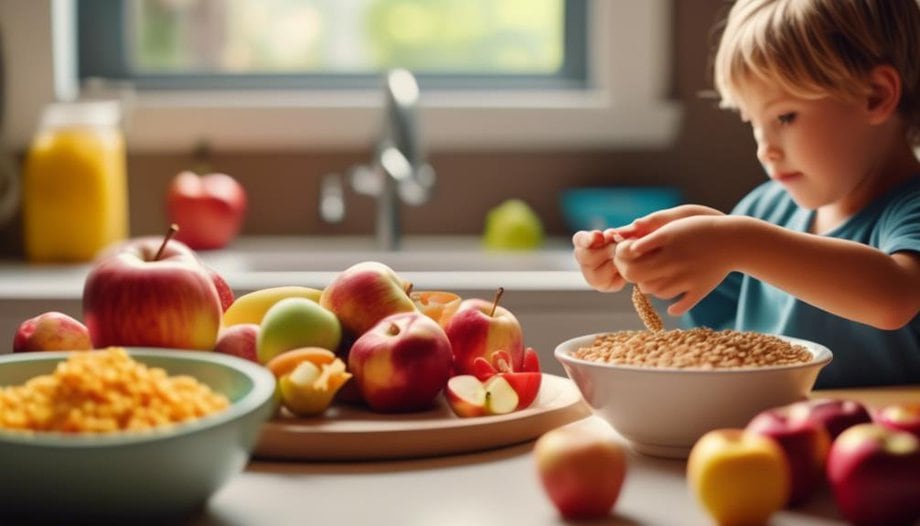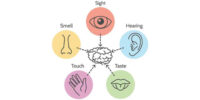Strategies for Reducing Added Sugars in Your Child's Diet With Real Life Examples

Strategies for reducing added sugars in your child's diet include:
- Swapping sugary drinks for healthier alternatives.
- Incorporating more whole foods into meals.
- Involving your child in meal planning and preparation.
Real-life examples of these strategies in action can inspire and motivate you on your journey towards a healthier future for your child.
Understanding the Impact of Added Sugars
Understanding the impact of added sugars is crucial for making informed decisions about your child's diet. Added sugars can be found in many processed and packaged foods, so it's important to read labels and choose whole foods whenever possible. By doing this, you can significantly reduce the amount of added sugars in your child's diet.
Excessive consumption of added sugars can lead to various health issues in children. It's recommended that children limit their added sugar intake to no more than 6 teaspoons (25 grams) per day. By reducing their intake, you can help prevent conditions such as obesity, dental cavities, and an increased risk of chronic diseases later in life.
There are several strategies that can be used to reduce added sugars in your child's diet. Substituting sugary drinks with water, plain milk, or whole fruits is one effective approach. Involving your child in meal planning and preparation can also empower them to make healthier choices. Educating them about the impact of added sugars can further enhance their understanding and motivate them to make better decisions.
Reading Food Labels for Hidden Sugars
When it comes to reducing added sugars in your child's diet, being aware of the sugar content in the foods you choose is crucial.
Take the time to read food labels and identify hidden sweeteners that may be lurking in your child's favorite snacks and drinks.
Sugar Content Awareness
To become more aware of hidden sugars in your child's diet, take the time to carefully read food labels and look for terms like sucrose, high fructose corn syrup, molasses, and other sweeteners on the ingredient list. It's important to understand that even 'healthy' foods like granola bars and yogurt can contain high amounts of added sugars.
When reading the nutrition label, pay attention to the 'Total Sugars' and 'Added Sugars' sections. The daily amount of added sugars recommended for children is no more than 25 grams. To reduce sugar intake, choose foods with lower amounts of added sugars or opt for products that are labeled as 'no added sugars.' Avoid products with added sugars listed as one of the first few ingredients.
Identifying Hidden Sweeteners
To accurately identify hidden sweeteners in your child's diet, it is crucial to carefully read food labels and familiarize yourself with terms such as sucrose, high fructose corn syrup, and molasses, among other common sweeteners found in the ingredient list. By understanding these terms, you can make informed choices about the foods you purchase for your child. To help you get started, here is a table outlining some common hidden sweeteners and where they can be found:
| Hidden Sweetener | Found in | Example |
|---|---|---|
| Sucrose | Processed foods | Cookies, cakes, and candy |
| High fructose corn syrup | Sweetened beverages | Soda, sports drinks |
| Molasses | Baked goods | Gingerbread cookies |
| Fruit juice concentrate | Fruit juices | Fruit punch, fruit-flavored drinks |
Swapping Sugary Drinks for Healthier Alternatives
Swap out sugary drinks for healthier alternatives to reduce added sugars in your child's diet. Sugary drinks like sodas, sports drinks, and fruit punch can contribute a large amount of added sugars to your child's diet, which can lead to various health problems.
Here are some healthier alternatives to consider:
- Water: Encourage your child to drink plain water throughout the day. Water is essential for hydration and has no added sugars or calories.
- Plain low-fat milk: Milk is a great source of calcium and other essential nutrients. Opt for plain low-fat milk instead of flavored varieties, which often contain added sugars.
- Whole fruit: Instead of fruit juice, provide your child with whole fruits. Whole fruits contain fiber, which can help reduce sugar intake and provide other important nutrients.
Making Homemade Snacks and Treats
When it comes to making homemade snacks and treats for your child, there are plenty of healthy options to choose from.
You can make homemade granola bars using wholesome ingredients like oats, nuts, and dried fruits.
For a lower sugar content, try baking cookies using natural sweeteners like mashed bananas or applesauce.
And if your child loves frozen treats, create fruit popsicles with no added sugars by blending fresh fruit and freezing in popsicle molds.
Making homemade snacks and treats allows you to have control over the ingredients and reduce the amount of added sugars in your child's diet.
Healthy Snack Recipes
Looking for healthier alternatives to packaged snacks? Try making homemade granola bars for a nutritious and delicious treat.
Here are three more healthy snack recipes to help you reduce added sugars in your child's diet:
- Bake cookies using natural sweeteners, like bananas or applesauce, instead of refined sugar. These options provide sweetness without the added sugars found in traditional cookies.
- Create fruit popsicles with no added sugars by blending fresh fruits and freezing them in molds. This way, your child can enjoy a refreshing and sweet treat while getting the benefits of whole fruits.
- Prepare trail mix with nuts and dried fruits for a satisfying and nutritious snack option. This mix provides a good balance of protein, healthy fats, and fiber, making it a great choice for a quick and energizing snack.
Sugar-Free Dessert Options
Consider making homemade snacks and treats as sugar-free dessert options to reduce added sugars in your child's diet. Experiment with homemade granola bars using natural sweeteners like mashed ripe bananas or unsweetened applesauce.
You can also bake cookies at home using alternative sweeteners. Try substituting sugar with mashed ripe bananas or unsweetened applesauce for a naturally sweet flavor.
Another option is to create fruit popsicles with no added sugars. Blend and freeze whole fruits with unsweetened yogurt or coconut milk for a refreshing and guilt-free treat.
Trail mix made with nuts, seeds, and unsweetened dried fruits is a low-sugar snack option to satisfy cravings.
Lastly, homemade smoothies using fresh fruits and vegetables can be a delicious and nutritious dessert without any added sugars.
Incorporating Whole Foods Into Meals
To incorporate whole foods into your child's meals, prioritize fresh fruits, vegetables, lean proteins, and whole grains for optimal nutrition. By focusing on these nutrient-dense foods, you can reduce the consumption of added sugars and promote healthy eating habits in your child.
Here are some practical ways to incorporate whole foods into your child's meals:
- Include a variety of fruits and vegetables:
- Serve sliced apples with a side of peanut butter for a nutritious snack.
- Add spinach or kale to smoothies for an extra boost of vitamins and minerals.
- Top whole grain pancakes or waffles with berries for a sweet and wholesome breakfast.
- Choose lean proteins:
- Include grilled chicken or fish in your child's lunch or dinner.
- Opt for beans or lentils as a plant-based protein source in soups or salads.
- Make homemade turkey or veggie burgers instead of store-bought ones.
- Opt for whole grains:
- Use whole wheat bread or tortillas for sandwiches and wraps.
- Substitute refined grains with brown rice or quinoa in stir-fries or side dishes.
- Offer oatmeal or whole grain cereal with fresh fruit for a nourishing breakfast.
Setting Boundaries and Establishing Healthy Habits
To establish healthy habits and set boundaries, it's important to build upon the previous subtopic of incorporating whole foods into your child's meals. By focusing on strategies for reducing added sugars in your child's diet, you can lay the foundation for a lifetime of healthy eating habits.
One effective strategy is to encourage your child to eat whole fruits instead of fruit juice. Whole fruits not only provide added fiber, but they also help to reduce added sugar consumption.
Additionally, choosing water and plain low-fat milk as healthier alternatives to sugary drinks can further limit your child's intake of added sugars. Opting for natural, unprocessed foods is another key strategy. These foods not only eliminate added sugars, but they also provide better nutrition for your child.
Cooking at home allows you to have more control over the foods consumed, which can help reduce sugar intake and promote healthier eating habits. Lastly, planning and packing healthy snacks in advance can help you avoid unhealthy choices and reduce your child's consumption of added sugars.
Being a Role Model for Your Child's Sugar Intake
Be a positive role model for your child's sugar intake by making mindful choices and prioritizing whole foods in your own diet. Here are some strategies you can implement to reduce the amount of added sugar in both your child's and your own diet:
- Choose water and low-fat milk over sugary beverages like soda or fruit juice. By doing so, you demonstrate the importance of hydration and avoiding excessive added sugars.
- Prioritize whole foods such as fruits, vegetables, lean proteins, and whole grains in your meals. Show your child the benefits of nourishing their bodies with nutrient-rich options.
- Limit processed foods and cook at home whenever possible. This way, you can control the amount of added sugars in your meals and teach your child the value of natural, unprocessed ingredients.
- Plan and pack healthy snacks ahead of time. Avoid grabbing sugary snacks and opt for options like fresh fruit, nuts, or yogurt. This helps your child understand the significance of making thoughtful food choices.
- Involve your child in meal planning and preparation. Educate them about the impact of excessive sugar intake while fostering a positive conversation about healthy eating habits.
Frequently Asked Questions
What Are the Practical Strategies to Reduce Added Sugar?
To reduce added sugar, swap sugary drinks for water and low-fat milk, choose whole fruits instead of juice, opt for natural unprocessed foods, plan and pack healthy snacks, cook at home, and make smarter choices when eating out.
What Are 3 Ways People Can Reduce Their Intake of Added Sugars?
To reduce added sugars, choose water and low-fat milk over sugary drinks, eat more whole fruits and vegetables, and opt for whole, unprocessed foods. These simple changes can have a big impact on your health.
What Are 5 Examples of High Sugar Foods That Children Should Avoid?
To reduce added sugars in your child's diet, avoid high sugar foods like regular soda (11-17 tsp), fruit drinks (3 1/2-5 tsp), sweetened coffees/teas (3-12 tsp), sports drinks (5-8 1/2 tsp), and flavored milk (2-4 1/2 tsp).
What Are the Other Ways of Reducing Sugar Intake in Our Diet?
To reduce sugar intake in your diet, try using sugar substitutes, practicing portion control, reading food labels, opting for healthy snacks and homemade alternatives, practicing mindful eating, encouraging water intake, limiting sugary beverages, taking a gradual reduction approach, and educating yourself on hidden sugars.










